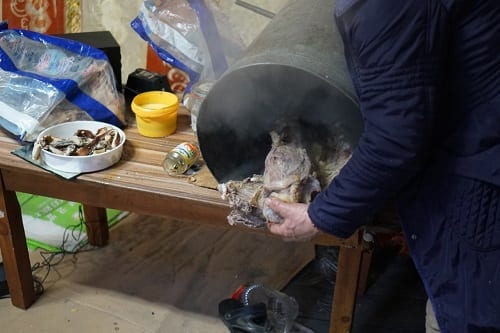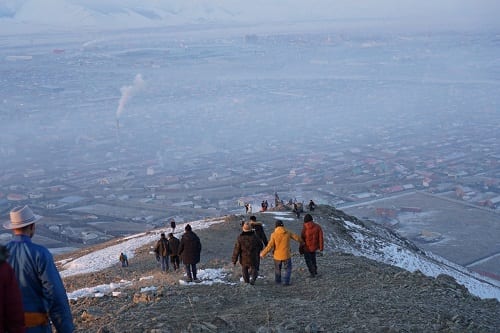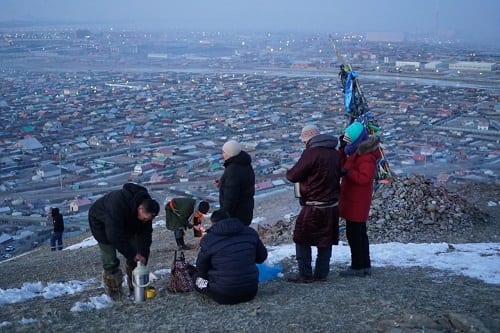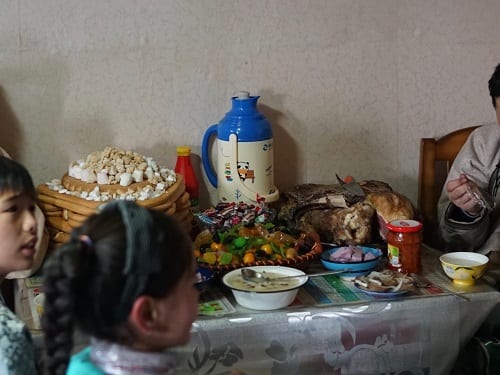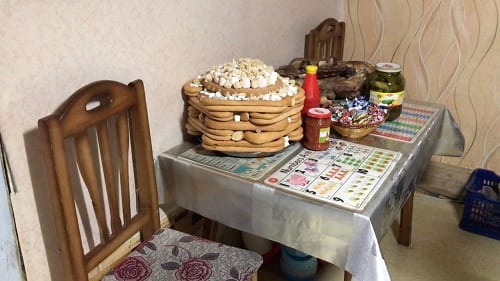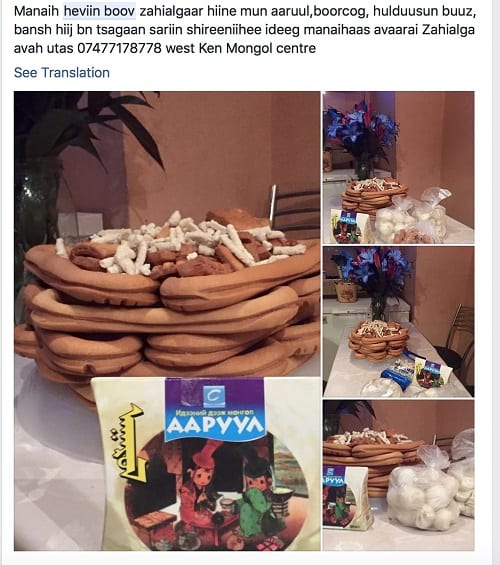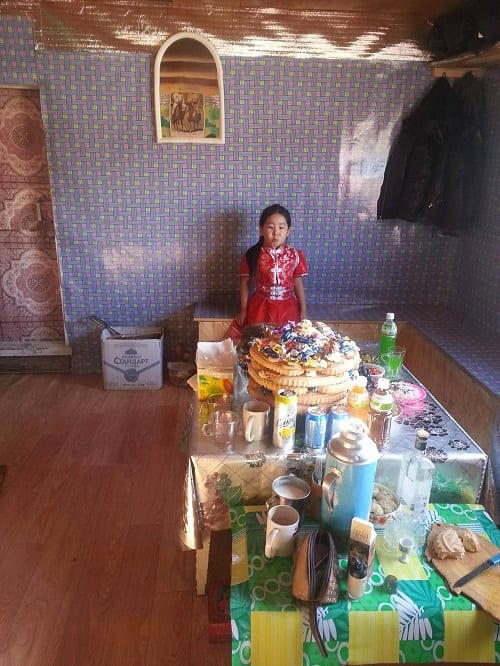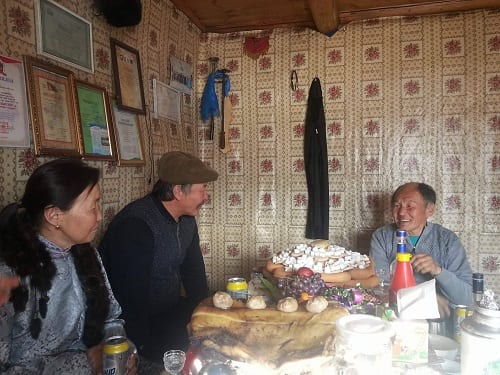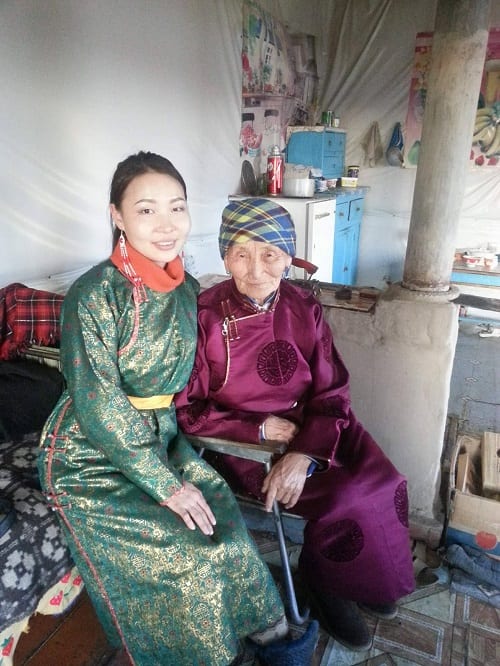White Tower, Yellow Dog: Kheviin Boov as the Centerpiece of Exchange and Transformation – 2018 Tsagaan Sar Gift Index
By uczipm0, on 1 March 2018
This post was written by Jessica Madison-Pískatá and Marissa J. Smith as part of the annual Tsagaan Sar Gift Index. Jessica Madison-Pískatá is a PhD Candidate in the Department of Anthropology at University of California, Santa Cruz. She is currently conducting fieldwork in Sukhbaatar aimag and Ulaanbaatar on post-human landscapes at sites of extraction. Marissa J. Smith is a Visiting Fellow with the Emerging Subjects group at University College London
Watching Tsagaan Sar preparations in Mongolia via the internet, this year Marissa Smith noted a distinct concern with products that comprise the tavgiin idee or ‘table food’. This consists largely of hard bread (kheviin boov, ul boov, eeven), dairy products (tsagaan idee), candy, salads, beverages, and other edibles that form the centerpiece of household guesting tables. Though early in the season of social media posting about Tsagaan Sar it looked like golden dogs made of salt might steal the show, the star of this year’s holiday is clearly the boov.
Decorative yellow and white Bankhar dogs made of salt. The finishing touch on the uul bov for Mongolian Tsagaan Sar in February. Seems to be a new trend this year. #Yearofthedog #Цагаансар pic.twitter.com/ooCsZ2YwTA
— Allyson Seaborn 🇲🇳 (@allysonseaborn) January 21, 2018
Bankhar dogs made of salt, for the ‘Yellow Earth Dog’ year, atop the structures of boov and tsaagan idee that comprise the centerpieces of tavgiin idee.
Decrease
Smith suggests that this concern reflects the continued poor state of the Mongolian economy, in which ties with the household and a few immediate family members on the one hand and the Mongolian nation on the other hand are emphasized. Over the past three years, the UCL Emerging Subjects Tsagaan Sar Index has documented links between inflation, an increasingly devalued tugrug, and ever-growing personal debt on the one hand and changes in patterns of hosting and gifting during Tsagaan Sar on the other, particularly a trend towards gifting less and less. As in previous years, Tsagaan Sar is being celebrated with traditional, national Mongolian products, and with fewer and fewer durable (i.e. clothing such as Mongolian-made wool socks) rather than consumable goods (i.e. food and drink, and increasingly less expensive ones – perhaps a component of the focus this year on boov with almost no mention of meat at all), and with gifting less money.
In the eastern countryside, Jessica Madison-Pískatá observed a similar shift in gift-giving practices. In addition to fewer durable goods, she also observed a continuing shift away from high-prestige consumables that must be purchased in Ulaanbaatar (i.e. limited edition New Year’s negj prepaid phone cards, tea bags, and vitamins) to edible ones that can easily be procured locally.
The amounts of money spent and debt taken, according to studies shared by Mongolian researchers, particularly the Mongolian Marketing Consulting Group (shared by Rebecca Empson), are comparable to those of previous years, but with somewhat less money spent and more debt taken than in previous years.
The Mongolian Marketing Consulting Group reports that those polled said that boov were the Tsagaan Sar item people were least worried about, gifts for guests the most anxiety-provoking, and that the biggest challenge in buying Mongolian gifts was their expense (74 percent of respondents).
Нэг өрхийн цагаан сарын зардал 2016 оныхоос 72.1 мянгаар нэмэгдэж, ₮1,074,831 болсон байна.
Улаанбаатар хотын өрхүүдийн 59%, хөдөө орон нутгийнхны 64% нь зээлээр #ЦагаанСар-аа тэмдэглэж.
Хотынхон 350 тэрбумаар цагаан сардаж. via @ZGMmn pic.twitter.com/RSeV98ubaY
— Anu Harchu 🇲🇳 (@AnuHarchu) February 20, 2018
Seventeen percent increase, compared to last year, in households taking loans for Tsagaan Sar, infographic based on MMCG Data.
Өрхийн нийгэм эдийн засгийн тоо мэдээлэлд үндэслэж цагаан сарын өрхийн дундаж зардлыг орлогын 3 түвшинд буюу бага, дунд, өндөр орлоготой өрхүүдийн хувьд тооцсноо хүргэж байна. #MIRIM #Цагаансар #зардал #mongolia pic.twitter.com/jvwYjpkw1P
— MIRIM Consultant LLC (@MIRIMConsultant) February 14, 2018
Tsagaan Sar expenditures by top, middle, and low-income households, MIRIM Consultant.
Perhaps most strikingly in contrast to past years, however, this year there is a notable focus on celebrating in one’s own household, as evidenced not only by the wealth of advertisements and conversations about tavgiin idee rather than gifts one would hand out to guests and obtain from hosts, but also by how the holiday was documented on social media. Rather than depict visits to other households, extended relations, friends, and coworkers, Mongolians seemed to be focusing on their immediate households and/or being more circumspect about making public whom they are connected with in what ways. (Evident to Smith through searching on Facebook for the popular greeting, Saikhan Shinleerei).
As many scholars of Mongolian sociality have emphasized, the wrong kinds of relations are not only ungenerative, they are anti-generative (Empson 2011, Empson and Delaplace 2007, High 2008, Hojer 2004, Pedersen 2011, Smith 2015). Showing the wrong kinds of Tsagaan Sar visits to the wrong people might contribute to claims on generosity and envious, malicious gossip, which undermine the relationships required to produce, reproduce, and exchange wealth, contributing to problems of excess, waste, and disease.
Excess, Waste, Disease
This year Smith also noted social media-based discourses of waste and harm associated with the celebration of Tsagaan Sar. Active members of the Facebook Group Expats in Mongolia, frequented by many long-term residents of Mongolia of foreign origin but who have married into Mongolian families, as well as Mongolian ‘re-pats’, levelled accusations about wasted kheviin boov, i.e. placed on ovoo rather than, as they argued it should be, distributed to people starving. The Twitter account of the Onom Foundation, an organization focusing on Mongolia’s world-record-busting liver disease statistics (and recently featured in a Bill and Melinda Gates Foundation-funded article in The Guardian), posted an infographic listing the calorific content of popular Tsagaan Sar foods and what activities celebrants should do to ‘burn off’ the calories. (Interestingly, however, boov are not listed.)
Цагаан сарын үеэр хэрхэн жин нэмэхгүй байх вэ? Баярын үеэр хэрэглэдэг хоол хүнснээс авдаг илчлэгийн хэмжээ, түүнийг хэрхэн “шатааж” болох харьцуулалтыг хүргэж байна. Хоногт авах илчлэгийн хэмжээнээс нэмэлт 3500ккал тутамд 420гр өөх болж биед үлддэг. #BHBC #ЦагаанСар #BHBC_UB pic.twitter.com/VaMdukp8eh
— Элгээ Хайрлая (@ElegMN) February 10, 2018
Madison-Pískatá also saw a shift away from meat and vodka at the Tsagaan Sar table, not only as it was offered, but also consumed. Throughout her visits, she observed multiple instances of guests refusing vodka to little protest, a marked increase from previous years that seems to follow the national trend of cutting back on vodka in favor of lower alcohol content options. At one household, guests were offered Bulgan airag (a high-prestige item, particularly in Sukhbaatar Province, where the vegetation is said to interfere with the flavor of mare’s milk) and red Bulgarian wine as an alternative to vodka. This is not to say that vodka does not still hold great ritual significance, and as in previous years, guests were still required to partake of the host’s vodka at least one to three times (depending on the age of the household—younger households hosting for the first time were more likely to hew closely to the customary three). However, visitors were not pressured to imbibe above the ‘ritual minimum’, especially if they were to cite health reasons for their refusal. Similarly, there was a decrease in both the serving and consuming of meat, especially sheep’s tail. Madison-Pískatá visited only one household that served tail on their Tsagaan Sar table, from which, despite the daughter reporting a steady stream of guests all day, there was only one small shaving eaten.
As is indicated in the data from the Onom Foundation, this concern does not extend to boov. In addition to boov and airag being increasingly swapped out for meat and vodka, wine and fish were also added to many Sukhbaatar Tsagaan Sar tables, bringing with them both the prestige of foreign products and the image of a kind of healthful exoticism. In the facebook group Chatnaa Okhindoo!’(‘You can do it, girls!’), where discussions often revolve around health and weight loss, both wine and fish are often brought up as part of healthy ‘foreign’ diets, most commonly as part of the trendy ‘Mediterranean Diet’, which is extolled as a panacea for good health and ‘wellness’, in the same breathless manner as it appears in women’s magazines in the Anglophone world.
These observations are in line with public ‘healthy lifestyle’ campaigns, women’s weight loss clubs, and a general concern with healthful eating that have been increasing in both number and relevance in Sukhbaatar Province over the last five or so years. In Madison-Pískatá’s interpretation, this indicates an increase in the bargaining power of individual agency when leveraged in interest of the health and well-being of the individual body. This is not, as Buyandelger points out, part of a post-socialist ‘transition’ narrative that argues for a unilateral shift towards the ‘individual’ at the expense of the ‘community’. Rather, it appears to follow the idea that a healthful individual body directly contributes to the greater health of the community. In her work on air pollution protests in Ulaanbaatar, Chisato Fukuda also emphasizes how the bodily experience of air pollution, particularly miscarried pregnancy, has drawn individuals together in collective response.
Smith notes that, on the flip side, as disorder in the social and its governance is intimately associated with chronic disease and responses have entailed reordering the social, relations between the state and the people have been of central importance. In past years, initiatives by the Mongolian military, President, and members of Parliament to celebrate with milk rather than vodka gained traction (Jargalsaikhan 2012) that is not evident in connection with the liver disease NGO’s initiative. The importance of the government as an actor or set of actors to be chastised in these narratives centrally concerned with proper ordering of social and individual action to align with stateness (tur) is demonstrated in posts on the Emerging Subjects blog by D. Bumochir (on ritual ‘punishment’ of politicians for mishandling mining agreements), Kh. Uyanga (maternal responses to measles outbreaks and associated infant mortality that offered mutual assistance and reprimanded government health agencies, see also Fukuda 2017), Sh. Tuya (the taking up of the Paris Climate Accord ‘shoe protest’ to demonstrate a public reprimanding the government in Ulaanbaatar), and Hedwig Waters (on the articulation of these critiques also among those who would not publicly expose or elevate themselves by organizing protest marches).
Shortage, Exhaustion, and Counterfeit
Further emphasis on boov also is reflected in news that these were being branded, counterfeited and seized, and that there were shortages of boov.
On February 8, a week before the first day of Tsagaan Sar, Marissa Smith shared an article from The UB Post on Facebook, which detailed how Ulaanbaatar government inspectors had seized not only potentially unhygienic but also counterfeit goods, including boov sold as associated with the Gandan Monastery and pickles with fake ‘Vagro’ (an imported Eastern European brand) labels which would be used to make many of the salads that are often part of the Tsagaan Sar table.
In a comment on the article, Jessica Madison-Pískatá confirmed from Mongolia that there is indeed increased concern over such branding, and added that by the third day of the New Year, stores in Ulaanbaatar had completely run out of boov, bread, and anything else that might be used to construct the towers of tsagaan idee that center the Tsagaan Sar table. Madison-Pískatá shared a facebook posting showing stacks of European-style bread (talkh) being used in place of kheviin boov, reposted with a wry comment that indicated frustration at the poster’s inability to find even this ersatz (counterfeit?) foreign boov.
“Even though kheviin boov is unfindable here we have had a good Tsagaan Sar (lit. ‘renewed well’). Are you all well?” Reposted with the comment: “Nevermind kheviin boov, when you can’t even find bread” (lit. ‘bread isn’t even available to buy’).
Revaluation, Recharge
While this post has had an overwhelmingly pessimistic cast, Smith ends with an eye to regenerative, transformative potential.
During her fieldwork in Erdenet, during the Tsagaan Sar of 2012, when the mining professionals she worked with already well perceived the coming economic bust, coworkers whose homes Marissa had not visited during Tsagaan Sar brought boov from their households to the workplace to share during coffee and tea breaks. This practice continues in Sukhbaatar and Ulaanbaatar, at least as part of distinct but adjacent gift exchanges with foreign guests. In Sukhbaatar, Madison-Pískatá received two pieces of kheviin boov from the parents of a close friend, along with borts, Russian candy, and aarul, given as a thank you gift in exchange for bringing vitamins from the United States (in addition to Tsagaan Sar gifts); and an additional piece (along with a book of Mongolian folktales) in exchange for performing a song at a pre-Tsagaan Sar dinner for foreigners in Ulaanbaatar, organized by the American Center for Mongolian Studies. (It remains to be seen what will become of this year’s boov once the tables are disassembled.)
Arranged in layers, boov are a ‘multiple’ part of the Tsagaan Sar spread, a quality of aspects of shamanic costume that Joseph Bristley (2015) has called attention to. Writing specifically about coins (zoos) on these costumes, Bristley extends the argument of Morten Pedersen (2011) about ‘multiplicity’ in shamanic costume (drawing on Martin Holbraad’s 2005 discussion of money and ‘multiplicity’) and highlights the ‘transformative’ powers of not only the shamanic costume, but also the power of money (itself in the Mongolian context at least not in fact completely, Bristley points out, transformable). Boov, Smith suggests, have kinds of multiple power that are like that of money, but also different, just as Bristley differentiates between the multiple coins and the multiple mirrors that might be found on a shamanic costume.
In her work on ninja gold mining, Mette High discusses wealth objects (both pastoral wealth and mining money) as “objects that retain strong attachments to the spirit world.” High argues that this attachment ties these two forms of wealth together, particularly in the way in which the nature of the attachment affects perceptions of household prestige. In conversations with pre-Tsagaan Sar shoppers around Gandan monastery, Madison-Pískatá also observed a connection between wealth, prestige, and the spirit world, particularly in the connection between what one might call ‘spiritually prestigious’ spaces and places (e.g. the shar edlel shops around Gandan monastery) and prestigious goods. One shopper indicated that he was on his way to Gandan specifically to buy ‘Otgontenger’ brand incense for the holiday, explaining not only that buying from this area (as opposed to Naran Tuul market, for example) was the safest way to ensure the product itself was jinkhene (authentic, genuine, pure); but that sourcing it from Otgontenger mountain ensured that it would have the highest quality in terms of both smell and spiritual effect. Madison-Pískatá argues that the same might apply to other Tsagaan Sar consumables like boov. Household prestige is in this way linked directly to the spirit world via the spaces it travels through on its way up the supply chain: sourced from a certain holy place, purchased from a shop in a spiritually prestigious neighborhood, and brought to the ritual space of the Tsagaan Sar table.
How then are boov powerfully money-like and not-money-like? It seems indeed that for this Tsagaan Sar season at least, they are not just inherently multiple and multiplicable, but have been carriers (moreso than money, issued by a government that is currently not enjoying widespread legitimacy and not aligned with stateness?) of both state-associated monastic and mountain powers, charging networks of interpersonal relationships consolidating while also extending beyond the Mongolian nation (pickles and their salads may have been underemphasized in this post!), renewing them with productive potential.

Taking advantage of new year distraction, a cow sneaks into town (herd animals are banned from the center in an effort to curb the spread of hoof-and-mouth disease. Photo by Jessica Madison-Pískatá.

Watching Yag Tun Shig (a very popular signing competition) during a lull in visitation. Photo by Jessica Madison-Pískatá.
References
Bayarsaikhan, Dulguun. Fake Labels Found on Tsagaan Sar Pastries. February 5, 2018.
Buyandelgeriyn, Manduhai, 2013. Tragic Spirits: Shamanism, Memory, and Gender in Contemporary Mongolia. Chicago: University of Chicago Press.
Bristley, Joseph, 2015. Transformation and Multiplicity: Zoos and the Power to Absorb Spirits in Mongolia. Inner Asia 17(1): 31-51.
- Bumochir. 2015. Mongolia’s Strategic Mine and the Conflict Between Civil Society, National Government, and Foreign Investors.
Empson, Rebecca, 2011. Harnessing Fortune: Personhood, Memory, and Place in Mongolia. Oxford: Oxford University Press.
Empson, Rebecca and Gregory Delaplace, 2007. The Little Human and the Daughter-in-Law: Invisibles as Seen Through the Eyes of Different Kinds of People. Inner Asia 9(2): 197-214.
Empson, Rebecca, Liz Fox, and Bumochir Dulam, 2017. Tsagaan Sar Gift Index – 2017. Emerging Subjects Blog.
Empson, Rebecca et al., 2016. Tsagaan Sar Gift Index – 2016. Emerging Subjects Blog.
Empson, Rebecca, Uranchimeg Ujeed, et. al., 2015. Tsagaan Sar Gift Index – 2015. Emerging Subjects Blog.
Fukuda, Chisato, 2017. A Fight to Breathe. Medical Anthropology Quarterly.
Griffin, Hannah, Mongolia’s Liver Cancer Crisis: No Other Country Has A Problem Like This. November 7, 2017. The Guardian.
High, Mette, 2017. Fear and Fortune: Spirit Worlds and Emerging Economies in the Mongolian Gold Rush. Ithaca: Cornell University Press.
High, Mette. 2008. “Wealth and Envy in the Mongolian Gold Mines. Cambridge Anthropology 27(3): 1-19.
Højer, Lars, 2004. The Anti-Social Contract: Enmity and Suspicion in Northern Mongolia. The Cambridge Journal of Anthropology 24(3): 41-63.
Holbraad, Martin, 2005. Expanding Multiplicity: Money in Cuban Ifá Cults. Journal of the Royal Anthropological Institute 11(2): 231-254.
Jargalsaikhan, Mendee, 2012. Mongolia – Without Vodka, Cheers with Milk. Mongolia Focus.
Kh. Uyanga, 2016. Health and the Economy: Measles, ASEM, and the Elections. Emerging Subjects Blog.
Pedersen, Morten, 2011. Not Quite Shamans: Spirit Worlds and Political Lives in Northern Mongolia. Ithaca: Cornell University Press.
Sh. Tuya, 2016. New Forms of Political Protests in Ulaanbaatar: Calling for Justice Through Shoes. Emerging Subjects Blog.
Smith, Marissa J. Treasure Underfoot and Far Away: Mining, Foreignness, and Friendship in Contemporary Mongolia. PhD Dissertation, Princeton University. http://arks.princeton.edu/ark:/88435/dsp01z603r0748
Waters, Hedwig. 2016. The ‘Slow Violence’ of Inaction: on the Apathy Towards Air Pollution. Emerging Subjects Blog.
 Close
Close




